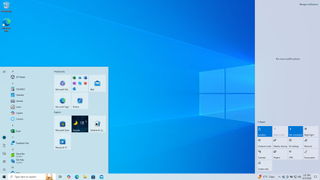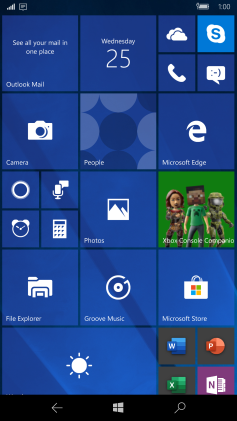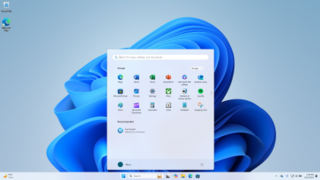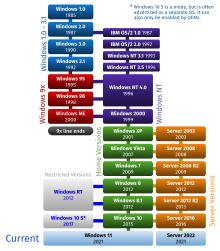Microsoft Windows was announced by Bill Gates on 10 November 1983, 2 years before it was first released. Microsoft introduced Windows as a graphical user interface for MS-DOS, which had been introduced two years earlier. The product line evolved in the 1990s from an operating environment into a fully complete, modern operating system over two lines of development, each with their own separate codebase.
Microsoft Windows is a product line of proprietary graphical operating systems developed and marketed by Microsoft. It is grouped into families and sub-families that cater to particular sectors of the computing industry -- Windows (unqualified) for a consumer or corporate workstation, Windows Server for a server and Windows IoT for an embedded system. Defunct families include Windows 9x, Windows Mobile, Windows Phone, and Windows Embedded Compact.

Microsoft Office, or simply Office, is a family of client software, server software, and services developed by Microsoft. It was first announced by Bill Gates on August 1, 1988, at COMDEX in Las Vegas. Initially a marketing term for an office suite, the first version of Office contained Microsoft Word, Microsoft Excel, and Microsoft PowerPoint. Over the years, Office applications have grown substantially closer with shared features such as a common spell checker, Object Linking and Embedding data integration and Visual Basic for Applications scripting language. Microsoft also positions Office as a development platform for line-of-business software under the Office Business Applications brand.

Neowin is a technology news website. Editorial focus is predominantly on Microsoft-related news, but the site also offers analysis and reporting on mobile news, tech trends, gadgets and new technological developments, as well as in-depth product reviews.
Windows Server is a group of server operating systems (OS) that has been developed by Microsoft since 1993. The first OS that was released for this platform is Windows NT 3.1 Advanced Server, an edition of Windows NT 3.1. With the release of Windows Server 2003, Microsoft started releasing new versions under the name Windows Server. The latest release of Windows Server is Windows Server 2022, which was released in 2021.

Windows IoT, short for Windows Internet of Things and formerly known as Windows Embedded, is a family of operating systems from Microsoft designed for use in embedded systems. Microsoft has three different subfamilies of operating systems for embedded devices targeting a wide market, ranging from small-footprint, real-time devices to point of sale (POS) devices like kiosks. Windows Embedded operating systems are available to original equipment manufacturers (OEMs), who make it available to end users preloaded with their hardware, in addition to volume license customers in some cases.
Microsoft Windows is the name of several families of computer software operating systems created by Microsoft. Microsoft first introduced an operating environment named Windows in November 1985 as an add-on to MS-DOS in response to the growing interest in graphical user interfaces (GUIs).
Windows NT is a proprietary graphical operating system produced by Microsoft as part of its Windows product line, the first version of which was released on July 27, 1993, and it lives on today since the latest version of Windows, 11, includes its technology.

Microsoft Build is an annual conference event held by Microsoft, aimed at software engineers and web developers using Windows, Microsoft Azure and other Microsoft technologies. First held in 2011, it serves as a successor for Microsoft's previous developer events, the Professional Developers Conference and MIX. The attendee price was (US)$2,195 in 2016, up from $2,095 in 2015. It sold out quickly, within one minute of the registration site opening in 2016.

Windows 10 is a major release of Microsoft's Windows NT operating system. It is the direct successor to Windows 8.1, which was released nearly two years earlier. It was released to manufacturing on July 15, 2015, and later to retail on July 29, 2015. Windows 10 was made available for download via MSDN and TechNet, as a free upgrade for retail copies of Windows 8 and Windows 8.1 users via the Microsoft Store, and to Windows 7 users via Windows Update. Windows 10 receives new builds on an ongoing basis, which are available at no additional cost to users, in addition to additional test builds of Windows 10, which are available to Windows Insiders. Devices in enterprise environments can receive these updates at a slower pace, or use long-term support milestones that only receive critical updates, such as security patches, over their ten-year lifespan of extended support. In June 2021, Microsoft announced that support for Windows 10 editions which are not in the Long-Term Servicing Channel (LTSC) will end on October 14, 2025.

Windows 10 Mobile was a mobile operating system developed by Microsoft. First released in 2015, it is a successor to Windows Phone 8.1, but was marketed by Microsoft as being an edition of its PC operating system Windows 10.
Windows Insider is an open software testing program by Microsoft that allows users globally who own a valid license of Windows 11, Windows 10, or Windows Server to register for pre-release builds of the operating system previously only accessible to software developers.
Windows 10 has several editions, all with varying feature sets, use cases, or intended devices. Certain editions are distributed only on devices directly from an original equipment manufacturer (OEM), while editions such as Enterprise and Education are only available through volume licensing channels. Microsoft also makes editions of Windows 10 available to device manufacturers for use on specific classes of devices, including IoT devices, and previously marketed Windows 10 Mobile for smartphones.
Windows 10 introduced a number of new elements, including the option to use a touch-optimized interface or a traditional desktop interface similar to that of Windows 7 along with live tiles from Windows 8. However, unlike previous versions of Windows, where most, if not all, major features for that release were completed by its RTM, Windows 10 continues to receive major features and changes beyond its initial release to market. Microsoft describes Windows 10 as an "operating system as a service" that will receive ongoing updates to its features and functionality. This is supplemented with the ability for enterprise environments to receive non-critical updates at a slower pace, and to use long-term support milestones that will only receive critical updates, such as security patches, over their ten-year lifespan of support.
Windows 10 is a major release of the Windows NT operating system developed by Microsoft. Microsoft described Windows 10 as an "operating system as a service" that would receive ongoing updates to its features and functionality, augmented with the ability for enterprise environments to receive non-critical updates at a slower pace or use long-term support milestones that will only receive critical updates, such as security patches, over their five-year lifespan of mainstream support. It was released in July 2015.

Windows Subsystem for Linux (WSL) is a feature of Microsoft Windows that allows developers to run a Linux environment without the need for a separate virtual machine or dual booting. There are two versions of WSL: WSL 1 and WSL 2. WSL is not available to all Windows 10 users by default. It can be installed either by joining the Windows Insider program or manually via Microsoft Store or Winget.
Windows 10 Mobile is a discontinued mobile operating system developed by Microsoft. It was released to manufacturing on November 20, 2015, and was made generally available on March 17, 2016. In October 2017, Microsoft announced that it would pause the active development of Windows 10 Mobile, and future development will be limited to maintenance releases and security patches. The last feature update is the Fall Creators Update. The last version of Windows 10 Mobile reached the end of life on January 14, 2020. Development for Windows 10 Mobile has completely ceased since then.
The Surface Neo is an unreleased dual-touchscreen 2-in-1 PC that was unveiled by Microsoft on October 2, 2019. Slated to be part of the Microsoft Surface family of devices, the Surface Neo was designed to be used in various "postures" for different use cases and multitasking scenarios involving its screens, and feature Windows 10X—a variant of Windows 10 designed exclusively for dual-screen devices. However, as of December 2023, over four years after the Surface Neo was announced, it is still unreleased, likely rendering it vaporware.

Windows 11 is the latest major release of Microsoft's Windows NT operating system, released on October 5, 2021. It succeeded Windows 10 (2015) and is available for free for any Windows 10 devices that meet the new Windows 11 system requirements.











